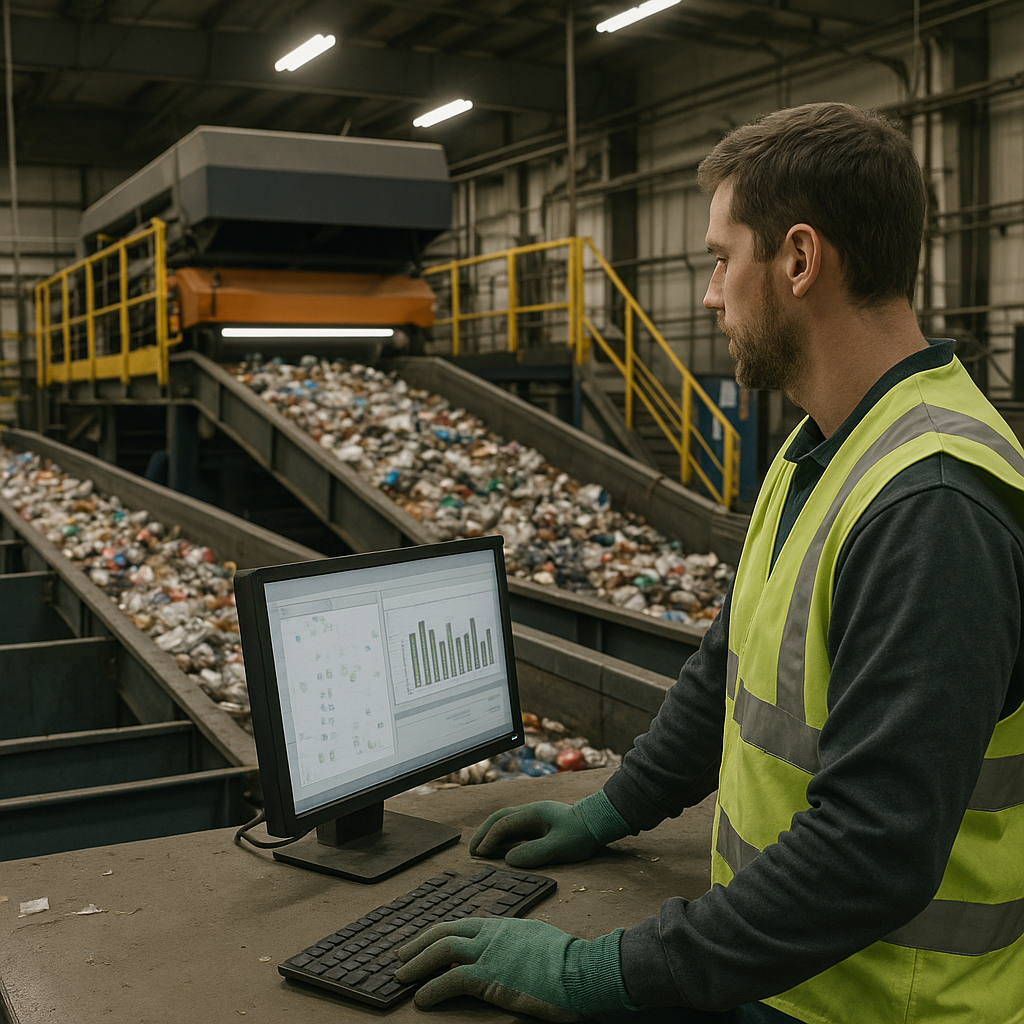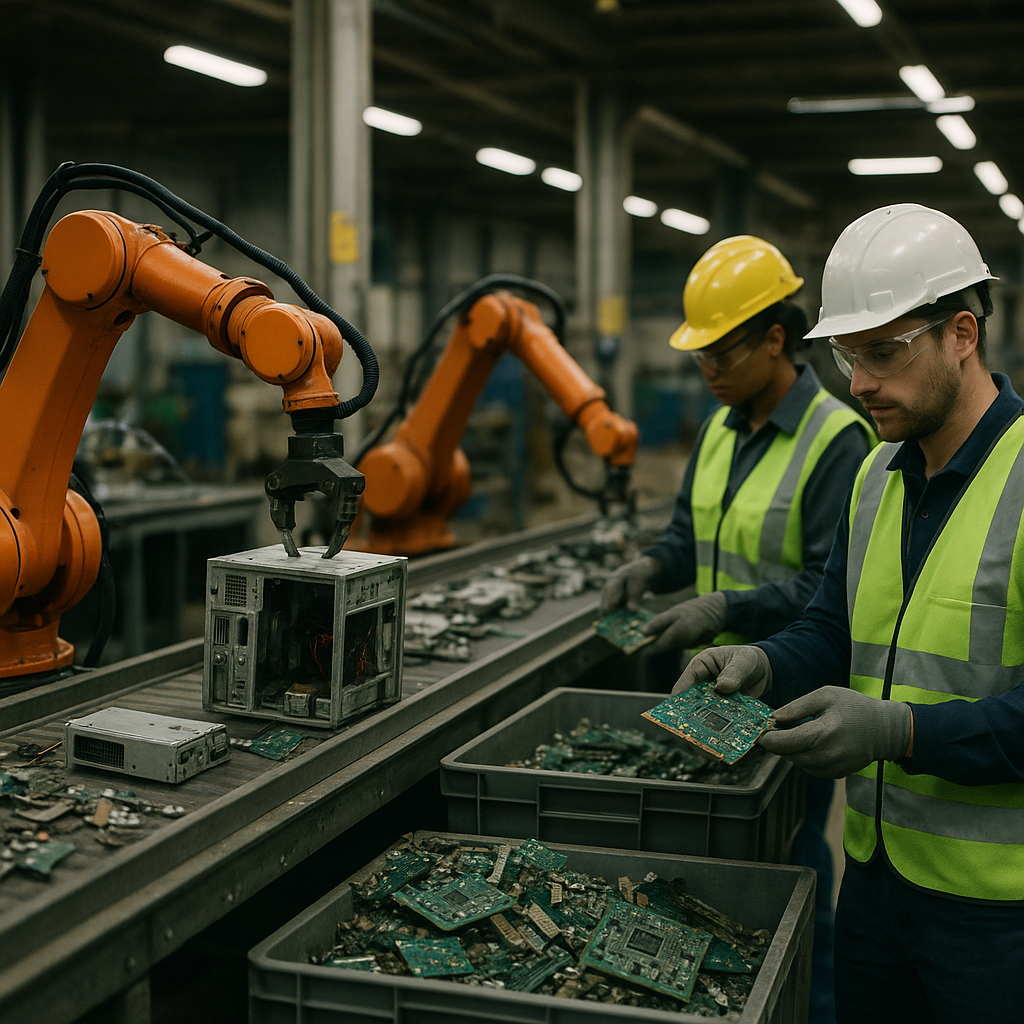5901 Botham Jean Blvd, Dallas, TX 75215
What Are Innovative Recycling Techniques Transforming Waste Management?
May 25, 2025Each year, the world generates over 460 million metric tons of plastic, with two-thirds used briefly before being discarded. This immense volume underscores the need for innovative recycling techniques essential to our environmental future. Traditional waste management can no longer keep up with our consumption patterns.
New recycling methods are transforming waste management by creating more efficient ways to recover and reuse materials from various waste streams. These advanced technologies improve sustainability and resource recovery while reducing reliance on landfills. They represent a fundamental shift from viewing waste as a problem to recognizing it as a valuable resource.
This transformation is occurring on multiple fronts. Advanced sorting technologies, improved materials recovery processes, breakthroughs in plastic recycling, and new approaches to e-waste management are collectively reshaping how we handle discarded materials in our circular economy.
How Are Advanced Sorting Technologies Improving Recycling Efficiency?

Advanced sorting technologies are transforming recycling operations by leveraging automation to shift from manual processes to high-precision operations. At their core, these technologies use sophisticated sensors and AI algorithms to accurately identify and separate materials in waste streams.
Prominent examples include optical sorting and robotic sorting systems. Optical sorting uses cameras and sensors to detect material properties, analyzing color, shape, and texture to make rapid sorting decisions. This process occurs at speeds beyond human capability.
Robotic sorting employs mechanical arms guided by AI to separate materials from conveyor belts. These robots can identify and remove specific items based on preprogrammed criteria, excelling at eliminating contaminants that could compromise recyclable batches.
These technologies offer superhuman vision. While humans might struggle to differentiate similar plastics, optical sorters can instantly recognize molecular compositions, akin to facial recognition identifying individuals in a crowd.
Implementing these technologies offers key benefits. They significantly increase recycling rates by capturing materials often missed in manual sorting. A facility in XYZ city reported substantial recycling rate improvements and reduced contamination levels after adopting these systems.
These systems also drastically reduce contamination in sorted materials. When recyclables are purer, they command higher market values and can be processed into higher-quality products. AI-driven sorting ensures streams of plastic, paper, metal, and glass remain separate and pure.
Additionally, advanced sorting technologies enhance resource recovery by capturing valuable materials that might otherwise end up in landfills, conserving natural resources and reducing environmental impact.
Despite these advantages, challenges exist. The initial investment can be substantial, making advanced systems less accessible for smaller operations without significant capital. Skilled operators and regular maintenance are also required for optimal functionality.
As costs decrease and technology becomes more accessible, wider adoption of these technologies is expected. The ongoing evolution of AI and sensor technology promises even greater sorting accuracy and efficiency.
NIR (Near-Infrared) technology plays a crucial role in modern sorting systems by detecting unique spectral signatures of materials, allowing precise identification of various polymer types. This capability is vital for effective plastic recycling.
The integration of AI with these sensor systems enhances sorting capabilities. Machine learning algorithms continuously improve through experience, adapting to waste stream variations and optimizing sorting decisions in real-time.
| Technology | Efficiency | Environmental Impact | Scalability | Cost |
|---|---|---|---|---|
| Chemical Recycling | High | Low | Medium | High |
| Enzymatic Recycling | Medium | Very Low | Low | High |
| Advanced Pyrolysis | Medium | Medium | High | Medium |
| Solvent-Based Recycling | High | Low | Medium | High |
| Microbial Decomposition | Low | Very Low | Low | Low |
| AI-Powered Sorting | High | Low | High | Medium |
| Plasma Pyrolysis | High | Medium | High | High |
| Blockchain | High | None | High | Medium |
| Biodegradable Plastics | Medium | Very Low | High | Medium |
| Electrochemical Recycling | High | Very Low | Low | High |
How Are E-Waste Recycling Technologies Advancing?

The rapid increase in electronic devices worldwide has led to a growing crisis, with over 50 million tons of electronic waste generated annually. This highlights the urgent need for effective recycling solutions. As technology evolves, so do the methods for processing and recovering valuable materials from discarded electronics.
Modern e-waste recycling technologies have advanced beyond traditional manual dismantling. Innovation is driving more efficient resource recovery while minimizing environmental impact, transforming waste into valuable resource streams.
Automated Sorting Systems
Advanced sorting technologies now use artificial intelligence and robotics to categorize electronic components quickly and accurately, identifying materials based on their unique properties. This automation reduces human error and exposure to hazardous substances.
Machine learning algorithms continuously improve sorting efficiency, increasing recovery rates of valuable metals and other components. Automated systems can process volumes of e-waste that manual sorting cannot handle.
Urban Mining: Extracting Value from E-Waste
Urban mining is a strategic approach to e-waste management, treating discarded electronics as a rich source of valuable metals and materials, often exceeding natural ore deposits.
Modern urban mining facilities resemble sophisticated material processing plants, using mechanical, thermal, and chemical processes to extract maximum value, recovering gold, silver, copper, and palladium from circuit boards and other components.
The economic and environmental benefits of urban mining are substantial. Recovering metals from e-waste requires less energy than extracting virgin materials and prevents hazardous substances from contaminating soil and water.
Hydrometallurgical Processes
Hydrometallurgical techniques are a major advancement in metal recovery from e-waste, using aqueous solutions and chemical reactions to dissolve and separate metals with greater precision than traditional methods.
Modern systems employ leaching, solvent extraction, and chemical precipitation, particularly effective for recovering precious metals like gold and silver. Innovations focus on developing more environmentally friendly leaching agents to replace harsh chemicals.
Closed-loop hydrometallurgical systems minimize water consumption and recycle process effluents, reducing resource usage and environmental impacts, offering a controlled alternative to high-temperature pyrometallurgical approaches.
Biometallurgical Innovations
Bioleaching is a promising sustainable technology in e-waste recycling, using microorganisms to extract metals from electronic components. Specific bacteria can oxidize and solubilize metals, making them easier to recover.
The environmental advantages are significant, as these processes operate at ambient temperatures, consume minimal energy, and reduce the need for harsh chemicals in metal extraction.
Research continues to identify more efficient microbial strains for metal recovery. Commercial applications of bioleaching for e-waste are expanding as the technology matures, demonstrating how nature-inspired solutions can address complex recycling challenges.
Integrated Recycling Systems
The future of e-waste recycling lies in integrated systems combining multiple technologies to maximize resource recovery while minimizing environmental impact. A typical facility employs mechanical preprocessing followed by various metallurgical recovery methods.
Data analytics and digital monitoring optimize these processing systems, allowing recyclers to track material flows and adjust operations for maximum efficiency. Integration creates economies of scale, improving the economic viability of recycling operations.
Advances in integrated systems enable the recovery of a wider range of materials. Beyond precious metals, these facilities now target rare earth elements essential for modern technology, addressing the increasing complexity of electronic devices.
| Technology | Key Benefits |
| AI-Powered Sorting | 99% sorting accuracy, 50% faster processing |
| Robotics for Disassembly | Improved safety, precise component recovery |
| Chemical Recycling | Recycles non-recyclable plastics, reduces environmental impact |
| Advanced Metallurgy | Enhanced precious metal recovery, reduces need for mining |
| IoT and Blockchain | Tracking and transparency, reduces illegal dumping |
Benefits of Advanced E-Waste Recycling
- Resource Conservation: Reduces demand for virgin material extraction through effective recovery of valuable metals and materials
- Environmental Protection: Prevents toxic substances from contaminating soil and water systems
- Energy Efficiency: Requires significantly less energy to recover metals from e-waste than mining raw materials
- Economic Value: Creates new revenue streams and green jobs in the recycling sector
- Circular Economy: Supports closed-loop material flows by returning valuable components to the production cycle
The advancement of e-waste recycling technologies is a critical response to our growing electronic waste challenge. Continued innovation and implementation of these recovery methods can transform waste into valuable resources for future generations.
What Are the Future Prospects and Challenges for Innovative Recycling?

The future of recycling stands at an exciting crossroads. AI and machine learning technologies are transforming waste management systems with unprecedented sorting accuracy and process optimization. These intelligent systems can identify materials that human sorters might miss, significantly improving resource recovery rates. The integration of robotics with AI vision technology further enhances these capabilities while protecting workers from hazardous environments.
Industry collaborations remain essential for scaling innovations. As breakthrough technologies emerge, partnerships between recycling facilities, technology developers, and manufacturers create the ecosystem needed to implement solutions at scale. These collaborations drive the circular economy forward by pooling resources and sharing knowledge across sectors.
Despite promising advancements, significant challenges persist. The economic viability of cutting-edge recycling technologies presents a major hurdle. High implementation costs can deter adoption, especially for smaller operations. Environmental trade-offs must be carefully evaluated, ensuring that new processes don’t create unintended consequences. Regulatory frameworks often struggle to keep pace with technological innovation, creating compliance uncertainties that slow progress toward more sustainable waste management.
The recycling landscape of tomorrow will ultimately be shaped by consumer awareness and behavior change. For recycling innovations to reach their full potential, public understanding and participation remain crucial. By supporting innovative recycling initiatives and making informed disposal choices, we can collectively build a more sustainable future. For guidance on implementing effective recycling solutions for your organization, contact Okon Recycling at 214-717-4083.
